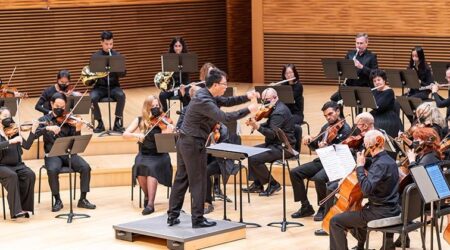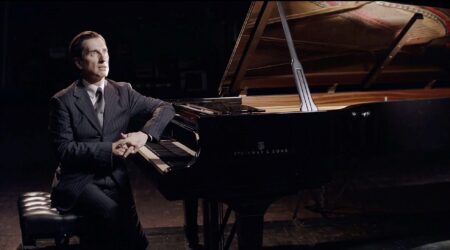Dachau Reconstructed: A Look at the Nazis’ First Camp
World War II is inarguably one of the most infamous periods of recent human tragedy, because it was not fueled by uncontrollable anger, ignorance, deprivation, revolution, or religion like so many other violent conflicts in history. The inhumanely sociopathic crimes committed by the Third Reich were cold, calculated, and systematic. The use of concentration, labor, and […]
World War II is inarguably one of the most infamous periods of recent human tragedy, because it was not fueled by uncontrollable anger, ignorance, deprivation, revolution, or religion like so many other violent conflicts in history. The inhumanely sociopathic crimes committed by the Third Reich were cold, calculated, and systematic. The use of concentration, labor, and extermination camps is one of the structural components that further set this war apart from so many others.
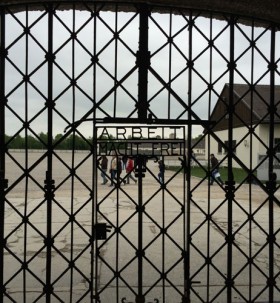
Germany was not the first country in history to use concentration camps, but the Nazis altered the purpose and association of such camps forever. The first camp of WWII was built outside of Munich in 1933, in the town of Dachau. The camp was initially intended to serve as a labor camp to hold the vast number of prisoners that traditional German holding facilities could no longer support. This camp was the first and served as a model for all other camps henceforth constructed in Hitler’s Germany.
I knew beforehand that the town of Dachau has always been occupied by normal people living normal lives, but the utter banality of it all still caught me off guard. I suppose a part of me expected to see dilapidated houses and blackened storefronts, to see residents with their heads hung in shame, all while being overshadowed by an ominously incessant dark cloud. But instead I saw pink and yellow trimmed houses and energetic inhabitants smiling and laughing. However, it was when they saw me that I noticed a change closer to my original assumptions, my foreign license plate announcing my deviance. Suddenly, even children hesitated, as if reprimanded by my presence. That was when it became clear to me that people in this town are like people in any other town, except that they seem to be born with an innate sense of guilt, of which they are always aware and they will never forget because tourists like me will always remind them.
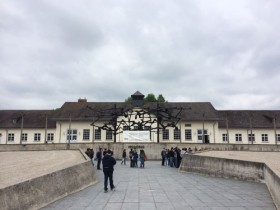
Contrary to common belief, the concentration camp is not located in the middle of Dachau. It is far from the town’s center, once camouflaged by vast fields and foreboding trees. What was once dirt and gravel walked upon by prisoners arriving from the town‘s main train station is now a perfectly paved walkway adorned with signs, newly constructed buildings, and yes, even a restaurant and a convenient bus stop. After a speedy walk of ten minutes I found myself face to face with the infamous gate marked, ‘’Arbeit Macht Frei,’’ or in contextual English, ‘’Work will set you free.’’ One of many sadistically ironic phrases the prisoners endured.
Directly behind the gate is a partially paved red brick road adjacent to what many mistake as old railroad tracks leading to a series of restricted buildings. Visitors are unanimously under the impression that these tracks are the remains of an old railway track that led prisoners directly to the front of the main camp. Visitors take photo after photo of the tracks that seem to abruptly and symbolically stop in front of a forgotten stretch of lawn. Lost in emotional thought, they stare teary-eyed while imagining an old rickety train slowing to a reluctant stop. Shuddering prisoners cramped inside, too devastated and in shock to acknowledge that they’ve made a stop. Visitors seem convinced that they can see the tears and hear the begging, pleading cries of prisoners as they file out of the train in shackles at gun point. Whereas this is an accurate depiction of camp arrivals, it is not a correct depiction of Dachau arrivals. Prisoners to this camp arrived at the main train station before they were forced to walk to the camp, regardless of the weather. The discontinued tracks seen by tourists today belonged to a part of history before Nazi terror was unleashed. They are actually narrow gauge tracks that were used to transport material to and from various factory buildings that occupied the site prior to 1933.

When I turned from the tracks I had no other choice but to enter through the main gate. I found myself at the edge of a large empty square with the original administration building to my right. This brought a natural sense of angst, to be standing in the square where so many prisoners stood in fear and hopelessness for hours during the roll call. In the Dachau camp, ‘’roll call’’ embodied more than the run-of-the-mill documentation of those present. This was the moment of the day during which guards chose which of the prisoners would eat, be beaten, sent off for medical experimentation, given mail, or in some cases, which among them no longer had the right to live. Once roll call finished, those left unseen for that day were sent off to work 12–14 hours in unsanitary, dangerous conditions with little to no food to sustain them. The end of the day brought little relief to prisoners, for yet another barbaric Nazi ritual was held: the Sick Parade. In the evening, sick prisoners were forced from their barracks to march in parade-fashion in front of the rest of the prisoners while the guards verbally and physically abused them.
After involuntarily staring into the vast quarry for some time imagining some of the cruelty enacted upon prisoners, I ventured to the administration building. Prisoners were taken here upon arrival to be processed, stripped of clothing, property, and any dignity they still had. Once stripped, they were showered en masse in a large open space that used to hold multiple linked shower heads. According to survivor testimonies, prisoners were hung from the (now removed) wooden cross bars between the tops of the shower arch beams, the residual marks of which are still visible. The focus of the memorial museum that now occupies the administration building is to inform visitors of what the prisoners endured on a daily basis: starvation, overcrowding, malnutrition, filth, abuse, and death, just to name a few.
Noticeable changes have been made to the camp since April 29, 1945 when it was liberated by American forces. Several memorials have been erected by survivors to serve as homages to both those who perished and those who survived the camp. The memorials include a Protestant Church, a bell tower adorned with a cross adjacent to a Catholic Church, a Russian Orthodox Chapel, and a Jewish memorial. Visitors are often shocked to see that the Jewish memorial is located in the least desirable of spots near the other memorials. This however, was not done out of disrespect or carelessness. Despite what some believe, the majority of prisoners at Dachau were not Jewish. Jewish prisoners were often sent to other camps, especially near the end of the war when many were sent to extermination camps outside of Germany. It wasn’t until the end of the war that a larger number of Jewish prisoners were brought to Dachau.
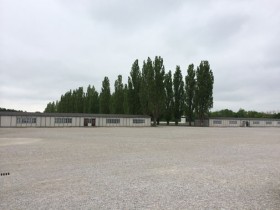
Visitors expect to see the numerous rows of barracks built by prisoners during the twelve years the camp operated as a labor camp, but are met instead with a large space occupied with rectangular cement foundations. After the war ended, the camp served a few different purposes, one of which was a refugee camp for over twenty years. By the time survivors had the courage to revisit the camp, refugees had been living in the barracks for so long that they were nearly unrecognizable. The survivors were so upset by this level of disrespect that all of the barracks were torn down. The cement foundations are all that remain of how the camp use to look before the war ended. Two reconstructed barracks are now located near the front of the roll call square, meant to serve as a physical idea of how the prisoners lived. The reconstructed barracks were designed as a timeline, illustrating what living conditions were like when the war started, and how they changed over the years as the camp became more overcrowded and desperate.
When I entered the mock barracks I was immediately met with a series of wooden bunk frames to my right. The absence of any bedding the prisoners may have had gave a realistic view of the narrowness of each bunk. There was no separation between any of the three- tiered bunks – prisoners were literally piled upon one another. The top bunk allowed less than two feet between the ceiling and its occupant. Through another narrow door I found myself in a similar room, this one representing how much the space of the same sleeping arrangement had changed over the years. Other than a few photos from the time, these bunks are all that remain as physical reminders of barrack life at Dachau.
The risk of being arrested and then thrown into a concentration camp was a real fear felt by many citizens of Europe. Anyone was fair game to the SS soldiers making their rounds: those in opposition to Hitler, Catholics, Protestants, the Russian Orthodox, homosexuals, Jews, intellectuals, the Polish, invalids, or the elderly. If the Nazis were consistent in anything they did, it was in their discrimination and cruelty against all mankind.
Jacqueline Perrier-Gillette is currently a resident of Paris, France, where she lives with her husband. Together the two of them operate their small translation company, giving Jacqueline the opportunity to observe the French and their culture up close. She is an avid reader, writer, and student of foreign languages.
By Jacqueline Perrier-Gillette


